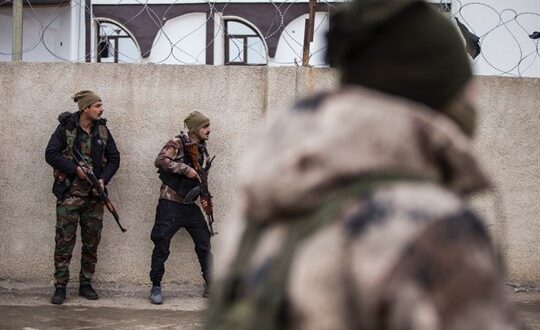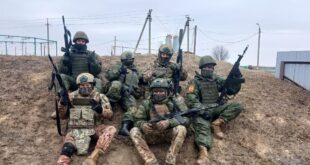The Islamic State, or ISIS, made global headlines recently on account of two significant developments in Syria: a prison uprising in Hasakeh in late January and the raid by U.S. special operations forces a week later, on Feb. 3, that resulted in the death of ISIS leader Abu Ibrahim al-Hashimi al-Qurashi.
Both events have focused attention on the Islamic State’s capacity to wage insurgency and mobilize militants in its former territory. But another factor that is potentially more important in assessing the group’s future prospects is the large number of ISIS members and sympathizers languishing in detention nearly four years after the group’s territorial defeat.
Analysts and scholars of armed groups have tracked the Islamic State’s attacks in meticulous detail since that defeat, and their findings show that despite alarming attacks like the Hasakeh uprising, the group’s overall ability to inflict significant damage on local populations has diminished over time. But a strictly military analysis insufficiently accounts for the popular and elite support the group retains, as well as the underlying dynamics that paved the way for the emergence of ISIS and al-Qaida before it.
After the U.S. invasion of Iraq in 2003, Islamist extremists made inroads in marginalized areas of Iraq’s west and northwest. The Islamic State’s growth was further fueled by the Iraqi government’s shift of attention in 2010 away from the marginalization of Sunni Arab Iraqis and the brewing jihadist insurgency.
But while al-Qaida and ISIS recruited many true believers in their extremist ideology, they also drew support from Iraqis and Syrians who were disenchanted with governments that failed to provide stability and security. Both groups also enjoyed support from key pillars of Iraqi society, including former military officers, prominent merchants, local community leaders and religious clerics. Combined, these factors enabled the kernels of jihadist extremism to flourish into full-fledged insurgencies.
This question of the Islamic State’s popular support was completely ignored after the fall of Baghouz in March 2019 that signaled the defeat of the territorial caliphate. Instead international attention evaporated and the resources needed for post-conflict reconstruction and resettlement never materialized.
In particular, several important questions largely went unanswered: What to do with the tens of thousands of captured ISIS fighters and their families, who all pledged to restore the caliphate with violence if necessary? What to do also with the thousands of foreigners—many with Western passports—who had traveled to Iraq and Syria to join ISIS?
The local problems are even more complex and important. What to do with the hundreds of thousands of Iraqis and Syrians who collaborated with ISIS and still share many of the group’s extreme, violent, racist ideas, but weren’t directly connected to crimes and therefore cannot face any legal prosecution? More difficult still is the question of what to do about the estimated 500,000 Iraqis who were known by their neighbors to sympathize with ISIS and have subsequently found themselves ostracized by those same neighbors, unable to return home.
On all these questions, the response from the international community has been an unconscionable disinterest. Western governments have refused to repatriate their citizens who fought for ISIS. They have likewise failed to build detention facilities in Iraq and Syria or send trained security officials from their countries to guard ISIS detainees there. Meanwhile, the cities and towns bombed with expensive Western munitions during the military campaign against ISIS have not been rebuilt. And the thorny problems of reintegration and accountability have been left to overwhelmed local authorities.
The Syrian Democratic Forces, or SDF, has resolutely tried to manage the large number of ISIS detainees it holds in makeshift and difficult-to-secure detention facilities. At the same time, there’s little pretense or even expectation of rehabilitation or reintegration. And many detention centers, like the one in Hasakeh, are located in communities that appear to include scores of likely ISIS sympathizers—at least as evidenced by reports of widespread skirmishes beyond last week’s prison compound uprising.
Estimates of how many suspected ISIS members and their families being detained in northeastern Syrian range from 45,000 by Human Rights Watch to 64,000 by the United Nations, of whom 80 percent are women and children. A U.N. report from June 2020 found that 58,000 children were being held in detention, of whom 8,000 were third-country nationals, meaning not from either Iraq or Syria.
Among the current detainees reported by Human Rights Watch are an unspecified number of nationals from 57 foreign countries. Reliable numbers are hard to come by when it comes to foreign fighters, in part, as Naureen Fink told PBS, due to an intentional lack of transparency by Western governments who are reluctant to repatriate their nationals and want to avoid public scrutiny of how they handle the small number of fighters that they have brought home.
In Iraq, the national government in Baghdad and the Kurdish regional government have tried to vet known ISIS fighters, while imprisoning those tried and convicted of crimes. That process has been imperfect at best, with many guilty parties able to escape justice through legal loopholes or paying bribes, while potentially innocent people have been convicted without due process, possibly to face the death penalty.
Meanwhile, local authorities have brokered the return of some internally displaced people, while experimenting with mechanisms to enable Iraqis with known ISIS ties or sympathies to sign denunciations of the group and return to society.
But the numbers involved in both exercises, which remain rough estimates, are daunting. At least 1.2 million Iraqis remain internally displaced from the fighting against ISIS. Government officials estimate there are at least 300,000 known ISIS members or supporters among the displaced in Iraq and 30,000 Iraqi ISIS members in Syrian detention camps. And in private discussions, Iraqi officials have told me that they estimate about 500,000 Iraqis should be classified as “ISIS families,” meaning members of families that willingly supported ISIS and enabled its rule.
Some of the local challenges of reconciliation defy easy solution, like how to handle the resettlement of known ISIS supporters to communities where many of the inhabitants were victims of the group’s brutality, as Mara Revkin has reported in compelling detail. But as problematic is the fact that these burdens are being unfairly borne by local authorities without adequate international assistance. Countries, like the U.S., that financed and provided weaponry for the campaign that defeated ISIS could help fund the reconstruction costs for cities heavily bombarded in the fighting. And Western countries and their allies and partners can and must take back their citizens who volunteered to fight for ISIS and prosecute them under domestic law, regardless of the cost and complexity.
Finally, there is no excuse for the indefinite detention of people who have been neither accused nor convicted of having committed any crime. It is a humanitarian catastrophe and ultimately a strategic calamity as well. Hundreds of thousands of former ISIS members and reputed supporters languish in limbo under degrading conditions. They must either face due process or be released and reintegrated into society. If not, this “lost generation” could potentially drive another wave of insurgency when they are eventually freed, whether by legal proceedings or an ISIS attack like the one on Hasakeh.
Rights Rundown
The day-to-day immiseration of Lebanon continues, but it’s important to keep an eye on the bigger picture: the deadly impunity that continues to characterize the country’s state institutions. The violent ruling factions of Lebanon usually exert power through quiet threats and intimidation, but they do not hesitate to resort to violence when they deem it necessary. The worst offender in this regard has been Hezbollah. Human Rights Watch released an excellent if depressing report into four unsolved murders that are believed to be politically motivated. The report finds that Lebanon’s judiciary and security forces, which have benefitted from considerable international support, have the capacity to solve political murders but largely choose not to. It serves as a reminder that Lebanon’s predatory rulers have a lot of crimes—and blood—on their hands, not just for the slow deaths of millions as the country’s economy and infrastructure continue to crumble, but for the quick and violent deaths of Lebanese who oppose the ruling clique.
Tunisian President Kais Saied announced Saturday that he will dissolve the Supreme Judicial Council, which oversees the independence of the country’s judiciary. The move completes the full consolidation of authoritarian power in Saied hands that began last July when he dissolved parliament and fired the prime minister. The prognosis for Tunisian democracy could still get worse—say, in the event of a military coup. But the end of judicial independence makes a quick return to democracy even more unlikely and suggests that Tunisia is in for a deepening period of authoritarianism.
 Eurasia Press & News
Eurasia Press & News



